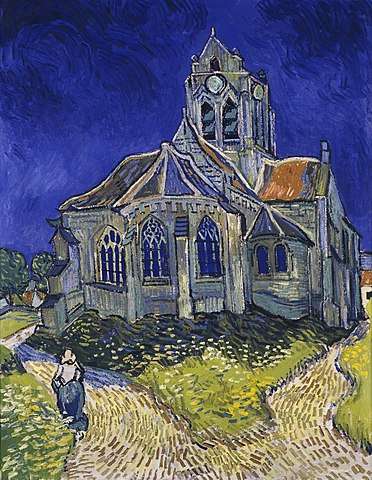Van Gogh Tour in Auvers-sur-Oise
If you’re a lover of art and history, a Van Gogh Church Painting Tour in Auvers-sur-Oise, France, should be on your must-visit list. Auvers-sur-Oise, a village located in the outskirts of Paris, holds a significant place in the world of art as it was once home to Vincent van Gogh during the final months of his life. Let’s go to an immersive journey through the landscapes and landmarks that inspired Van Gogh’s iconic church painting.
- From €1000 – USD $1,175 up to 6 persons upon level of customization
- 4 to 6 Hour private tour guide from Paris with stops and highlights
- Official Licensed Tour English Speaking Guides with local expertise
Paris Private Tours by Car Service
| Pricing | Duration | Features | Location | Passengers |
|---|---|---|---|---|
| From 580 € | 4 hours | Driver only | Paris | 1 to 7 |
| From 850 € | 4 hours | Guide+driver | Paris | 1 to 6 |
| From 1,180 € | 6 hours | Guide+driver | Paris | 1 to 6 |
| From 1,450 € | 6 hours | Guide+driver+museum | Paris | 1 to 6 |
| From 1,650 € | 8 hours | Guide+driver | Champagne | 1 to 6 |
| From 1,850 € | 12 hours | Guide+driver | Normandy | 1 to 6 |
| Quote | X hours | Your choice | Your choice | Your choice |
The Connection with Auvers-sur-Oise
Auvers-sur-Oise became a second home for Van Gogh, and it is here that he created some of his most celebrated works. We explore the reasons behind Van Gogh’s choice to settle in this serene village and the impact it had on his artistic expression.
After his stay in Arles and then in the psychiatric hospital of Saint-Rémy de Provence, Vincent van Gogh settled in Auvers-sur-Oise. His brother Théo, worried about his health, encouraged him to meet Doctor Gachet, a painter himself, who agreed to take care of him. During the two months that elapsed between his arrival in Auvers on May 21, 1890 and his death on July 29, the artist produced around 70 canvases.
In his letters, Vincent Van Gogh evokes his sufferings, his suicidal thoughts and his will to persevere, not being “master of (his) existence”, wishing “learn to want to live, even when suffering”. A sign of his ever-present Christian faith. Indeed, Vincent van Gogh was a believer, a Bible reader and was even an evangelist.
Van Gogh Church Painting
Van Gogh’s choice to devote himself to painting
As a trainee preacher for an evangelical mission, he was however quickly removed. His propensity to strip himself of material possessions in order to give everything to the poor and follow the example of Christ was considered too radical. This failure led to a long period of depression and will be decisive in Van Gogh’s choice to devote himself to painting. Although he broke with the Church, reading the Bible continued to mark his life. In one of his last letters addressed to his brother Theo, Vincent evokes a letter which was for him “like a Gospel, a deliverance from anguish”.
Van Gogh Church Painting Tour in Auvers-sur-Oise
Church Painting Tour is one of the paintings created by the artist during his time in Auvers-sur-Oise. Let’s take a closer look at Van Gogh Church Painting “The Church at Auvers,”, l’église Notre-Dame-de-l’Assomption. This work and others of the same genre illustrate the artistic influence of Van Gogh on the expressionist painters: here the distortion of reality is flagrant. Its deformations and the refusal of perspective characterize expressionist works. The plastic choices of van Gogh announce the works of the fauves and the expressionist painters, and move away from impressionism.
Expressionism is the projection of a subjectivity that tends to distort reality in order to inspire an emotional reaction in the viewer. Representations are often based on distressing visions, distorting and stylizing reality to achieve the greatest expressive intensity. The first signs of Expressionism appeared in the late 19th century, particularly in Edvard Munch’s series The Scream, as well as in the development of the work of Van Gogh and James Ensor. The art critic Wilhelm Worringer was the first to speak of “Expressionism” in 1908.
Van Gogh’s approach and his Church Painting Tour in Auvers-sur-Oise
This painting is the only one that Vincent van Gogh devoted to the church of Auvers. The Church of Our Lady of the Assumption is a Catholic parish church located in Auvers-sur-Oise, in the department of Val-d’Oise. It was founded towards the end of the 11th century by Philip I. Then rebuilt under the leadership of Adelaide of Savoy. She often resided in the royal manor to the north of the church after the death of her husband Louis VI in 1137.
This reconstruction begins with the eastern parts and ends with the nave, which has an elevation on three levels with a triforium. It is done in the late Romanesque style still evident in the capitals. Quickly switching to the nascent Gothic style with pointed arch windows and ribbed vaults. The apse to the north is still purely Romanesque. However, it is probably not earlier than 1137. Two windows of the chevet were reworked in the 13th century in the Gothic Rayonnant style. It accentuates the stylistic difference between these two parts which are actually contemporary. If we compare this painting with the Cathedrals of Claude Monet, painted shortly after, we measure what separates van Gogh’s approach from that of the Impressionists.
In the 20th century, the church acquired worldwide fame thanks to Vincent Van Gogh’s painting, The Church of Auvers-sur-Oise, painted in 1890.
How the natural beauty of Auvers-sur-Oise inspired van Gogh
Nature played a profound role in Vincent van Gogh’s life and art. We explore how the natural beauty of Auvers-sur-Oise inspired him and discover the spots where he set up his easel to capture the stunning landscapes on canvas. Vincent van Gogh’s legacy continues to live on, not only through his paintings but also through the lasting impact he had on the art world.
The village also welcomed many painters. Charles-François Daubigny settled there in 1861; his widow opened her garden to Van Gogh. Cezanne, Pissarro and a host of other artists, often foreigners, came there to seek the picturesqueness of a hilly Ile-de-France landscape, bathed by the Oise, with houses built on the hillside, between woods and fields.
A must see : Van Gogh’s room in the Ravoux Inn
On 20 May 1890 Vincent van Gogh moved into the Ravoux Inn for 3,50 francs per day bed and board. He had room number 5, a simple attic room of 7 sq. meters, lit by a sky light. On 28 and 29 July 1890 Theo van Gogh was present during his brother Vincent’s last moments. Out of superstition the landlords never again rented out this “room of the suicide” which occupied such an essential place in the artist’s spiritual universe.
This haven of peace where “there is nothing to see… but everything to feel” has remained untouched since 1890. The room is empty. You cannot find the slightest relic to touch. You just stand there and feel…the presence of history. The room next-door, number 6, was occupied by another artist, Anton Hirschig, who knew no fame. Its spare and spartan furnishing gives an idea of how artists lived at the end of the 19th century.
This journey ends in the neighbouring attic room with an audiovisual projection In the Footsteps of Van Gogh. It retraces the artist’s stay in Auvers-sur-Oise via his paintings and correspondence, and a selection of contemporary photographs. The video has been designed by Dominique-Charles Janssens, President of the Institut Van Gogh, to enable the visitor to discover Auvers-sur-Oise through the eyes and the talent of Van Gogh.
Besides Van Gogh church painting in Auvers-sur-Oise
-
Pay Homage at Vincent van Gogh’s Final Resting Place in Auvers cemetery
Vincent van Gogh’s grave, covered in ivy, shows the life of the genius. Although seemingly stable, Vincent van Gogh, 37 years old, went out into one of the fields and shot himself in the abdomen. He died on July 29, 1890 in his brother Theo’s arms in his little room at Auberge Ravoux. Vincent van Gogh was laid to rest in the cemetery in Auvers-sur-Oise the day after he succumbed to his wounds. Because of his suicide, no service was allowed at Eglise Notre-Dame-de-l’Assomption-d’Auvers. However, a service in his honour was held in the Auberge Ravoux. Theo died six months after Vincent and his remains, initially buried in Holland, were moved beside his brother in 1914.
-
Follow The Artists’ Pathway besides Van Gogh Church Painting Tour in Auvers-sur-Oise
Van Gogh’s stay in Auvers-sur-Oise was a bittersweet chapter in his life. The serene landscapes, vibrant colors, and close-knit community offered him temporary solace from his inner turmoil. Through his artworks, Van Gogh immortalized the beauty of Auvers-sur-Oise and shared his unique perspective with the world.
For 70 days, alternating between confidence and anxiety, he frantically painted and drew 74 paintings and numerous drawings. He also produced his first engraving.
On July 27, in the middle of a field, he shot himself with a revolver and died on the 29th, in his room at the Ravoux inn.
-
Visit Doctor Gachet’s House museum (van Gogh doctor)
Paul Gachet (1828 – 1909) devoted his medical thesis to melancholy in 1858. In 1872, he bought a house in Auvers-sur-Oise where he received Cezanne, Guillaumin and Pissarro. A non-conformist spirit, a follower of homeopathy, Gachet welcomed Van Gogh as a friend as much as a patient. The painter had lunch at his house first every Sunday. He painted his portrait, bouquets, views of the garden and, finally, his daughter Marguerite. In gratitude for her care, he offered her paintings.
An amateur painter and engraver under the pseudonym Paul van Ryssel, Gachet gave Van Gogh the opportunity to engrave and print his first and only etching at his home. When Vincent died, Theo offered him many paintings in gratitude for the support he had given his brother. Between 1949 and 1954, his children Paul and Marguerite Gachet donated 9 paintings, drawings, the engraving plate. They also give the palette used for the portrait of Marguerite, and objects painted by the artist to the Louvre.
The doctor’s collection of paintings and engravings has been dispersed but the old wallpapers still bear the marks of past skirmishes and Doctor Gachet’s hand press, sold in 1943, has been returned to its place thanks to a loan.
-
Enjoy The Daubigny Museum (art center)
Classified as a historic monument in 1991 and labeled “Maison des illustrious” in 2014, Maison Atelier Daubigny was built in 1861 by Charles-François Daubigny. It was the meeting point for his landscape friends, Corot, Daumier and Berthe Morisot, to name just a few. You will admire on the walls of the workshop, the exceptional imprint that each one left.
-
Uncover The Myths Of Absinthe At The Museum
Located between the Château and the Auberge Ravoux, the Absinthe Museum recreates the atmosphere of the Belle Époque cafés. Absinthe, fashionable, was the favorite drink of poets and artists. The original works it contains allow us to discover its importance in the social and cultural life of the 19th century.
-
The beautiful castle close to Van Gogh Church Painting Tour in Auvers-sur-Oise
Château d’Auvers was built around 1635 by Zanobi Lioni, a rich Italian financier associated with Marie de Medici. The building possessed a terraced roof in Italian style, harmonious gardens arranged in a series of terraces, ponds and fountains. It also has two orangeries to the north and south as well as a belvedere overlooking the village and the valley of the Oise. Château d’Auvers offers the “Impressionist Vision” experience, plunging the visitor into the world of Impressionist painting. It is an immersive, emotional and sensory experience.
Van Gogh church painting tour in Auvers-sur-Oise
In conclusion, a Van Gogh Church Painting Tour in Auvers-sur-Oise is an enchanting journey that combines history, art, and nature. Walking in the footsteps of the great artist, surrounded by the picturesque landscapes that inspired his genius, is an experience that every art lover should cherish.
Enjoy a Vincent van Gogh church painting tour in Auvers-sur-Oise with private car service from Paris. PARIS BY EMY also offers customizable Paris private tour guide as well. Indeed, we are tailoring the experience to your interests in addition to outside Paris.


